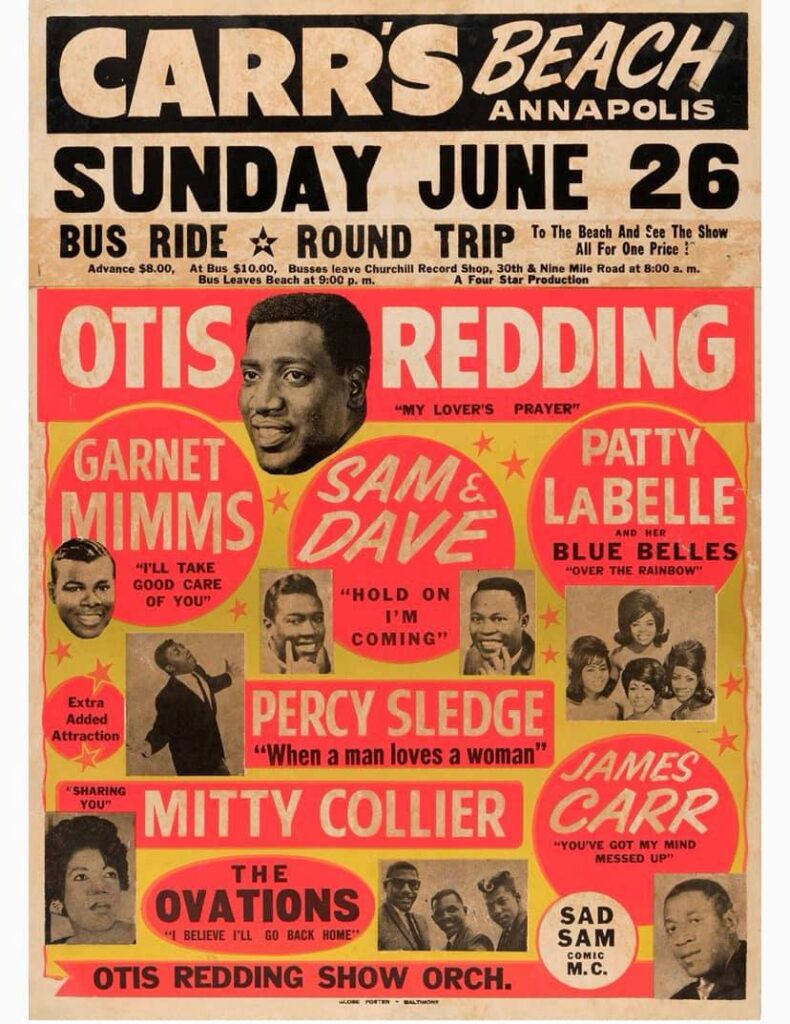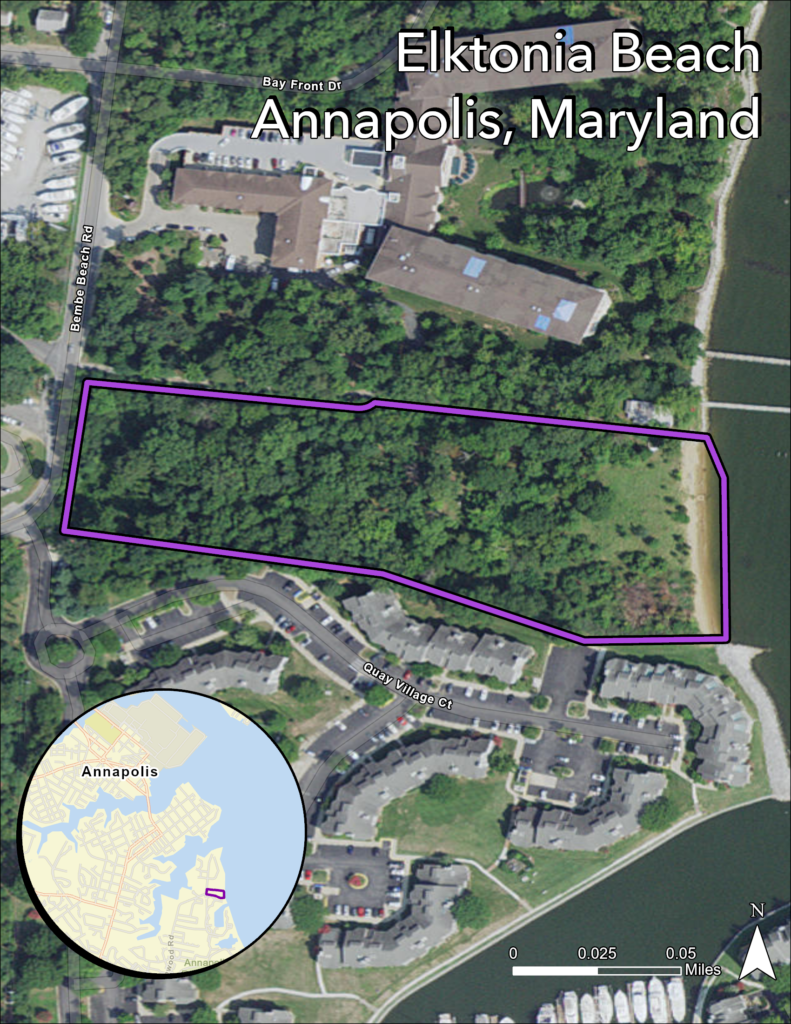“When Anne Arundel County in Maryland was segregated, there was a place called Carr’s Beach (now Chesapeake Harbor), a summer haven for African Americans where the coolest people on the planet in music came: soul musicians Little Richard and James Brown, jazz legend Billie Holiday. Carr’s Beach was a major stop for these legendary artists.” – Annapolis Mayor Gavin Buckley
THE BEACH
Carr’s Beach, at one time one of the leading beaches for east coast African Americans, was known affectionately called, “The Beach.” Although “The Beach” no longer exists as a vacation getaway spot, Carr’s Beach and its neighboring Sparrow’s Beach were two of the major Chesapeake Bay resorts that catered exclusively to African Americans between the 1930s and the 1960s. Owned by sisters, Elizabeth Carr Smith and Florence Carr Sparrow, the beaches were a vacation retreat for black families in the Mid-Atlantic region.
ORIGINS OF CARR’S BEACH
The origins of Carr’s Beach can be traced back to 1902 when Frederick and Mary Wells Carr purchased 180 acres of farmland on the Annapolis Neck Peninsula. While the family farmed the land as early as 1909, the Carr family hosted picnics and church outings and took in boarders. In 1926, two years before Frederick Carr’s death, the family founded Carr’s Beach.

In 1931, Florence Carr Sparrow, one of the daughters who inherited the family’s land, created Sparrow’s Beach just north of Carr’s Beach, and the two resorts operated side by side but as separate businesses. Carr’s and Sparrow Beaches attracted thousands of visitors from Philadelphia, Pennsylvania; New York; Baltimore, Maryland; Wilmington, Delaware; Pittsburgh; and Washington, D.C. who frequented the beach for swimming. During the week, the Beach hosted summer day camps, church picnics, and other family and community-centered events. By three o’clock, however, many visitors made their way to Carr’s Beach Pavilion to dance to the latest hit songs by locally or regionally popular entertainers.

Following the death of Elizabeth Carr in 1948, Carr’s Beach came under the control of William L. “Little Willie” Adams, a businessman/numbers operator who formed Carr’s Beach Amusement Company and infused badly needed capital into the resort’s operations. With his resources, Adams expanded both the entertainment and recreation opportunities for old and young alike. He insured that by the 1950s Carr’s Beach was one of the major stops for major African American artists and musicians on the Chitlin’ Circuit, a group of venues throughout the East and South which catered to black audiences. Among the entertainers who performed on weekends during the summer months were jazz legends such as Billie Holiday, Duke Ellington, Count Basie, Ella Fitzgerald, Dinah Washington, and Lionel Hampton, as well as soul artists Ray Charles, James Brown, Jackie Wilson, Little Richard, Otis Redding, the Supremes, the Commodores, Cab Calloway, The Temptations, Ike and Tina Turner, The Shirelles, and Wilson Pickett. Rock ‘n’ Roll pioneers Fats Domino and Buddy Holly also performed at Carr’s Beach. On July 21, 1956, an estimated 70,000 people traveled to Carr’s Beach to hear Chuck Berry perform, although only 8,000 made it past the gates because the grounds were filled beyond capacity. By the early 1960s, the list of popular entertainers included Little Richard, Lloyd Price, Etta James, Aretha Franklin, the Shirelles, the Coasters, and the Drifters.

In addition to the annual rival dance contests held between African American beachgoers from Washington, D.C. and Annapolis, local residents recalled that whites also visited the beaches, making them two of the first venues in Maryland which developed a sizeable interracial clientele. Because of the crowds, the beaches organized their own special police force. As a safe and welcoming vacation destination, Carr-Sparrow Beach attracted the attention of people from diverse racial backgrounds who enjoyed good black music. Carr’s Beach was often the last stop for the entertainers who played the Howard Theatre in D.C. and/or the Baltimore Royal Theatre before they headed Down South to perform.

By the early 1960s, the black freedom movement ended Jim Crow and the popularity of Carr-Sparrow Beaches. A 1962 performance by James Brown drew 11,000 fans, but it marked the last of the major crowds drawn to the area. In the late 1960s, new owners attempted to revive the heyday of the resort (and appeal to a new audience) by inviting groups like Led Zeppelin or Rare Earth. In 1973, the beaches hosted their last show, a performance by Frank Zappa.

CARR’S BEACH / ELKTONIA BEACH
Elktonia Beach, a 5-acre waterfront parcel on the Chesapeake Bay, is the last remnant of the original 180-acre property purchased by freedman, Frederick Carr, in 1902. Carr’s and Sparrow’s Beaches were privately owned and operated by Frederick Carr’s daughters, Elizabeth Carr Smith and Florence Carr Sparrow. Carr’s Beach (1930s-1970s), represented the heart of entertainment throughout the mid-Atlantic region and welcomed Blacks during a time of segregation. It has been a nearly 20-year goal of Blacks of the Chesapeake Foundation (BOCF) to preserve the remaining 5 acres of The Beaches.

PRESERVING THE LEGACY
After years of advocacy and fundraising, in 2022, the City of Annapolis, Blacks of the Chesapeake, Chesapeake Conservancy and the state of Maryland entered into an agreement with The Conservation Fund to acquire the property through a patchwork of funding including federal, state and city Program Open Space funds. Additional support was provided by Governor Larry Hogan and the Maryland Department of Natural Resources, and federal appropriations were secured by U.S. Senator Ben Cardin. BOCF also received a Parks & Playgrounds Infrastructure Grant through the efforts of State Senator Sarah Elfreth. In August 2022, a signing ceremony took place, transferring the property to the City of Annapolis and creating a new city park with beach access, Elktonia-Carr’s Beach Heritage Park.
Elktonia-Carr’s Beach Heritage Park is the last remaining vestige of the original iconic property. Preservation of Elktonia Beach as a heritage park and interpreting its history for the public will ensure its legacy is fully recognized. As a public park, now all people can visit, experience and enjoy the natural and cultural resources of the Chesapeake Bay

During the intense era of Jim Crow laws and forced racial segregation, Blacks were prohibited from visiting beaches like Ocean City or Atlantic City. In response, Carr’s Beach, Sparrow’s Beach and neighboring Elktonia Beach were vacation getaways and prominent venues that welcomed Blacks and hosted renowned Black musicians, including Billie Holiday, Count Basie, James Brown, Ray Charles, Wilson Pickett, Otis Redding and Little Richard. The route these and many other Black musicians traveled became known as the “Chitlin Circuit.”


